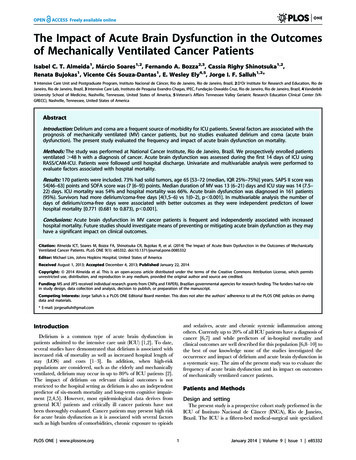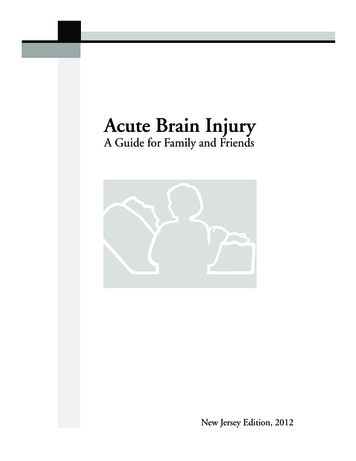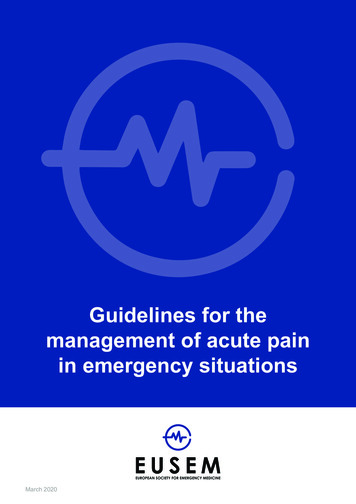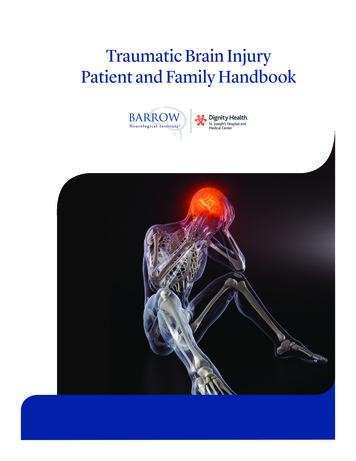
Transcription
The Impact of Acute Brain Dysfunction in the Outcomesof Mechanically Ventilated Cancer PatientsIsabel C. T. Almeida1, Márcio Soares1,2, Fernando A. Bozza2,3, Cassia Righy Shinotsuka1,2,Renata Bujokas1, Vicente Cés Souza-Dantas1, E. Wesley Ely4,5, Jorge I. F. Salluh1,2*1 Intensive Care Unit and Postgraduate Program, Instituto Nacional de Câncer, Rio de Janeiro, Rio de Janeiro, Brazil, 2 D’Or Institute for Research and Education, Rio deJaneiro, Rio de Janeiro, Brazil, 3 Intensive Care Lab, Instituto de Pesquisa Evandro Chagas, IPEC, Fundação Oswaldo Cruz, Rio de Janeiro, Rio de Janeiro, Brazil, 4 VanderbiltUniversity School of Medicine, Nashville, Tennessee, United States of America, 5 Veteran’s Affairs Tennessee Valley Geriatric Research Education Clinical Center (VAGRECC), Nashville, Tennessee, United States of AmericaAbstractIntroduction: Delirium and coma are a frequent source of morbidity for ICU patients. Several factors are associated with theprognosis of mechanically ventilated (MV) cancer patients, but no studies evaluated delirium and coma (acute braindysfunction). The present study evaluated the frequency and impact of acute brain dysfunction on mortality.Methods: The study was performed at National Cancer Institute, Rio de Janeiro, Brazil. We prospectively enrolled patientsventilated .48 h with a diagnosis of cancer. Acute brain dysfunction was assessed during the first 14 days of ICU usingRASS/CAM-ICU. Patients were followed until hospital discharge. Univariate and multivariable analysis were performed toevaluate factors associated with hospital mortality.Results: 170 patients were included. 73% had solid tumors, age 65 [53–72 (median, IQR 25%–75%)] years. SAPS II score was54[46–63] points and SOFA score was (7 [6–9]) points. Median duration of MV was 13 (6–21) days and ICU stay was 14 (7.5–22) days. ICU mortality was 54% and hospital mortality was 66%. Acute brain dysfunction was diagnosed in 161 patients(95%). Survivors had more delirium/coma-free days [4(1,5–6) vs 1(0–2), p,0.001]. In multivariable analysis the number ofdays of delirium/coma-free days were associated with better outcomes as they were independent predictors of lowerhospital mortality [0.771 (0.681 to 0.873), p,0.001].Conclusions: Acute brain dysfunction in MV cancer patients is frequent and independently associated with increasedhospital mortality. Future studies should investigate means of preventing or mitigating acute brain dysfunction as they mayhave a significant impact on clinical outcomes.Citation: Almeida ICT, Soares M, Bozza FA, Shinotsuka CR, Bujokas R, et al. (2014) The Impact of Acute Brain Dysfunction in the Outcomes of MechanicallyVentilated Cancer Patients. PLoS ONE 9(1): e85332. doi:10.1371/journal.pone.0085332Editor: Michael Lim, Johns Hopkins Hospital, United States of AmericaReceived August 1, 2013; Accepted December 4, 2013; Published January 22, 2014Copyright: ß 2014 Almeida et al. This is an open-access article distributed under the terms of the Creative Commons Attribution License, which permitsunrestricted use, distribution, and reproduction in any medium, provided the original author and source are credited.Funding: MS and JIFS received individual research grants from CNPq and FAPERJ, Brazilian governmental agencies for research funding. The funders had no rolein study design, data collection and analysis, decision to publish, or preparation of the manuscript.Competing Interests: Jorge Salluh is a PLOS ONE Editorial Board member. This does not alter the authors’ adherence to all the PLOS ONE policies on sharingdata and materials.* E-mail: jorgesalluh@gmail.comand sedatives, acute and chronic systemic inflammation amongothers. Currently up to 20% of all ICU patients have a diagnosis ofcancer [6,7] and while predictors of in-hospital mortality andclinical outcomes are well described for this population [6,8–10] tothe best of our knowledge none of the studies investigated theoccurrence and impact of delirium and acute brain dysfunction ina systematic way. The aim of the present study was to evaluate thefrequency of acute brain dysfunction and its impact on outcomesof mechanically ventilated cancer patients.IntroductionDelirium is a common type of acute brain dysfunction inpatients admitted to the intensive care unit (ICU) [1,2]. To date,several studies have demonstrated that delirium is associated withincreased risk of mortality as well as increased hospital length ofstay (LOS) and costs [1–3]. In addition, when high-riskpopulations are considered, such as the elderly and mechanicallyventilated, delirium may occur in up to 80% of ICU patients [2].The impact of delirium on relevant clinical outcomes is notrestricted to the hospital setting as delirium is also an independentpredictor of six-month mortality and long-term cognitive impairment [2,4,5]. However, most epidemiological data derives fromgeneral ICU patients and critically ill cancer patients have notbeen thoroughly evaluated. Cancer patients may present high riskfor acute brain dysfunction as it is associated with several factorssuch as high burden of comorbidities, chronic exposure to opioidsPLOS ONE www.plosone.orgPatients and MethodsDesign and settingThe present study is a prospective cohort study performed in theICU of Instituto Nacional de Câncer (INCA), Rio de Janeiro,Brazil. The ICU is a fifteen-bed medical-surgical unit specialized1January 2014 Volume 9 Issue 1 e85332
Acute Brain Dysfunction in ICU Cancer Patientsfeatures of delirium: (1) acute onset or fluctuating course, (2)inattention, (3) disorganized thinking, and (4) altered level ofconsciousness. To be considered CAM-ICU positive, the subjectmust display features 1 and 2, and either 3 or 4. The CAM-ICUwas applied every morning by two trained investigators (I.C.A andV.C.S-D) to every eligible patient during the first 14 days of ICUstay. The ICU and hospital mortality rates from any cause werealso assessed.This study was supported by institutional funds and did notinterfere with clinical decisions related with patient care. TheEthics Committee of the Instituto Nacional de Câncer in Rio deJaneiro approved the study (Number 144/2009) and the need forinformed consent was waived.in the care of patients with cancer [8], with the exception of bonemarrow transplant patients.Briefly, during the study period (February 2010 to February2012), every adult cancer patient ( 18 yrs) that required ICUadmission was consecutively evaluated. Patients in completeremission .5 yrs, those ventilated for more than 24 h prior toICU admission, patients ventilated for less than 48 h in the ICUand readmissions were not considered. Legal blindness anddeafness and the inability to speak Portuguese as well as moribundpatients (expected to die ,24 h) were also excluded. The mainoutcome of interest was hospital mortality.Definitions, Selection of Participants and Data CollectionDemographic, clinical and laboratory data were collected usingstandardized case report forms and included main diagnosis forICU admission, the Simplified Acute Physiology Score (SAPS) II[11] the Sequential Organ Failure Assessment (SOFA) score [12],comorbidities, and cancer- and treatment-related data. Level ofarousal was measured using the RASS score [13] rates a patient’slevel of agitation/sedation on a 10-point scale ranging from 25(unarousable, not responsive to voice or physical stimulation) to 4(combative). Coma was defined as a RASS score of minus 4(responsive only to physical stimulus) or minus 5 (unresponsive tophysical stimulus) of any cause as previously defined [14].Delirium was diagnosed with the CAM-ICU [15]. The CAMICU was developed for use in critically ill, intubated patients and isa validated delirium detection tool with high sensitivity andspecificity and high inter-rater reliability [16] that was validated inPortuguese by our group [17]. The CAM-ICU assesses fourData processing and Statistical AnalysisData entry was performed by the investigators (I.C.A, V.C.S-D)and consistency was assessed with a rechecking procedure of arandom sample of patients. Data were screened in detail by twoinvestigators (J.I.F.S., I.C.T) for missing information, implausibleand outlying values.Standard descriptive statistics were used. Continuous variableswere reported as median [25%–75% interquartile range (IQR)].Univariate analysis was used to identify factors associated withhospital mortality. Two-tailed P-values ,0.05 were consideredstatistically significant. Univariate and multivariable logisticregression were used to identify factors associated with hospitalmortality. Variables yielding P-values below 0.2 by univariateanalysis were entered into a forward multivariable logisticregression analysis. Clinically relevant variables such as: sepsis,Figure 1. Study Flow Diagram.doi:10.1371/journal.pone.0085332.g001PLOS ONE www.plosone.org2January 2014 Volume 9 Issue 1 e85332
Acute Brain Dysfunction in ICU Cancer Patientsuse of sedatives, chemotherapy, cancer status, age and comorbidities were forced into the model. Multivariable analysisresults were summarized by estimating odds ratios (OR) andrespective 95% confidence intervals (CI). Possible interactionswere tested. The area under the receiver-operating characteristiccurve was used to assess the models’ discrimination. The SPSS13.0 software package (Chicago, Illinois, USA) and Prism 3.0(Graphpad, USA) were used for statistical analysis.Diagnosis of acute brain dysfunction: AssociatedCharacteristics and OutcomesAfter excluding patients deeply sedated and unarousable withRASS deeper than 23 during the entire study period, deliriumwas evaluated with the CAM-ICU in 126 patients (74% of theentire eligible patient population). Daily interruption of sedation[18] was a part of routine ICU care and performed according tolocal protocol based on Kress et al [18].Overall, delirium was diagnosed by the CAM-ICU in 92.8% ofpatients (n 117/126) of the included arousable patients. Detailedcomparisons between patients with and without a diagnosis ofacute brain dysfunction (ABD) are also depicted on table 1.Regarding hospital mortality, a comparison was performedbetween survivors and non-survivors (including the whole cohort).As expected, survivors presented lower severity of illness asexpressed by the SAPS II scores (50 [43–60] vs 56(47–63),p 0.011). Additionally, ventilator free-days and delirium-comafree days were higher in survivors. The results regarding thecomparison of other variables are shown in Table 2.Variables selected in the univariate analysis (those with pvalues,0.2 and others with clinical interest regardless of p-valuesuch as: age, charlson index, cancer type and status) were enteredin multivariable analysis. In addition to the SAPSII, only acutebrain dysfunction as well as delirium/coma free-days were selectedin the final models and independently associated with hospitalResultsCharacteristics of the study populationAfter the initial screening of 1090 consecutive ICU admissions,a total of 170 patients that fulfilled inclusion criteria were enrolledin the study (Figure 1). The main characteristics including cancerrelated variables of the study population are depicted in Table 1.Overall, ICU and hospital mortality were 54.7% and 66.4%%,respectively. One hundred and thirteen patients (66.4%) wereadmitted to the ICU due to a medical condition while emergencyand elective surgery represented 25.2% and 8.2% of cases,respectively. At ICU admission, sepsis was the most frequentdiagnosis (n 108, 63.5%).Table 1. Demographic and clinical variables of patients according to the presence of acute brain dysfunction.VariablesAll Patients(n 170)Acute BrainDysfunction(n 161)No acute braindysfunction (n 9) P-value*Age (years)63(53–72)62(53–72)64(50–68)0.78Male gender, n (%)100(58.8%)93(57.7%)7(77.7%)0.36Performance status (3–4), n (%)34(20%)33(20.4%)1(11.1%)0.68Cancer status (recent diagnosis/relapse/progression), n (%)161(94.7%)152(94.4%)9(100%)0.99Solid tumor, n (%)125(73.5%)118(73.2%)7(77.7%)0.99Tumor extension (locally advanced/distant metastasis), n (%)78(45.8%)75(46.5%)3(33.3%)0.64SAPS II score son comorbidity index (points)2(2–3)2(2–3)3(2–4.5)0.50SOFA score 7(66.4%)6(66.6%)0.99Sepsis, n (%)108(63.5%)105(65.2%)3(33.3%)0.08Respiratory failure (excluding sepsis), n (%)27(15.8%)22(13.6%)5(55.5%)0.006PaO2/FiO2 0.60Sedatives, n (%)168(98.8%)161(100%)7(77.7%)0.002MV LOS (days)13(6–21)13(6.5–20)15(5–28)0.99ICU LOS l LOS (days)26(14–39)26(13–39)36(21–49)0.13ICU mortality, n (%)93(54.7%)90(55.9%)3(33.3%)0.34Hospital mortality, n(%)113(66.4%)110(68.3%)3(33.3%)0.06End of life care, n (%)30(17.6%)27(16.7%)3(33.3%)0.25Type of admissionMedical n (%)Main reasons for ICU admission*For comparisons among patients with and without the diagnosis of acute brain dysfunction.SAPS II - Simplified Acute Physiology Score II; SOFA - Sequential Organ Failure Assessment; ICU - intensive care unit; LOS –length of stay; Performance is status is definedaccording to the Eastern Cooperative Oncology Group (ECOG) scale.Results expressed as median (25%–75% interquartile range) and number (%).doi:10.1371/journal.pone.0085332.t001PLOS ONE www.plosone.org3January 2014 Volume 9 Issue 1 e85332
Acute Brain Dysfunction in ICU Cancer PatientsTable 2. Comparison of Survivors and non-survivors.VariablesSurvivors (n 57)No Survivors (n 113)P-valueAge (years)64(53–70.5)62(53–73)0.53Male gender, n (%)31(54.3%)69(61%)0.41Performance status (3–4)10(17.5%)24(21.2%)0.68Cancer status (recent diagnosis/relapse/progression), n (%)55(96.4%)106(93.8%)0.71Solid tumor, n (%)45(78.9%)80(70.7%)0.27Tumor extension (locally advanced/distant metastasis), n (%)30(52.6%)48(42.4%)0.25SAPS II score (points)50(43–60)56(47–63)0.0112Charlson comorbidity index (points)2(2–3)2(2–3)0.54SOFA score (points)7(5.5–9)7(6–9)0.60Type of admission - Medical, n (%)32(56.1%)81(71.6%)0.05Sepsis, n (%)37(64.9%)71(62.8%)0.86P/F score (points)280(190–380)270(200–384)0.85Sedatives, n (%)56 (98.2%)112 irium/coma-free days4(1,5–6)1(0–2),0.0001MV LOS (days)9(6.5–18)14(6–22)0.29Ventilator free days (days)3(1–5.5)0(0-0),0.0001ICU LOS (days)14.5(10–20.5)13(6–23)0.33Hospital LOS ournal.pone.0085332.t002Data on the mortality stratified by 3 categories of duration ofdelirium/coma free days is also provided in Figure 3.Understanding the evidence of a spectrum that encompassesdelirium, coma plus delirium and coma, we analyzed separatelythose patients that were comatose though all the study period. Asexpected when the 44 patients with RASS deeper than 23 for thewhole study period were compared to the remaining 126 patienswe observed that they had higher SOFA scores ( 8[6–10] vs 7[5–8], p 0.07), less ventilator-free days ( 0[0-0] vs 1[0–1], p,0.01),increased ICU (93.1% vs 41.2%, p,0.0001) and hospitalmortality (95.4% vs 56.3%, p,0.0001) as compared to arousablepatients regardless of diagnosis of delirium.mortality (Table 3). As there was potential colinearity between thepresence of acute brain dysfunction and coma-delirium free-daystwo models were fitted containing either the acute braindysfunction or delirium-coma free-days. In multivariable analysis,acute brain dysfunction (OR 5.00 [95% CI, 1,15–21.68],p 0.03) and delirium-coma free-days (0.771 [0.681 to 0.873],p,0.001) were associated with increased hospital mortality.We also analyzed mortality of two groups stratified by themedian duration of (median 1) of delirium/coma free-days andobserved higher cumulative mortality (84.8 vs 46.1%, p 0.001) inpatients that presented more acute brain dysfunction (Figure 2).Table 3. Multivariable analyses of factors associated with increased hospital mortality.VariablesCoefficientOdds-Ratio (95% CI)P-valueModel containing the Delirium/ComaDelirium/Coma1.6105.00 (1,15–21.68)0.03SAPSII Score (points)0.0291.03 (1,002–1.059)0.03Surgical admission20.6590,52(0.259 to 1.031)0.06Constant22.155Model containing the Delirium/Coma Free DaysSAPSII Score (points)0.0321.032 (1.003 to 1.063)0.028Coma-Delirium Free Days1.210.771 (0.681 to 0.873),0.001Constant20.325Model containing the Delirium/Coma: Area under receiver operating characteristic curve 0.67 (95% CI, 0.59 to 0.74).Model containing the Delirium/Coma- Free Days: Area under receiver operating characteristic curve 0.75 (95% CI, 0.68–0.81).SAPSII - Simplified Acute Physiology Score II; CI – confidence interval.doi:10.1371/journal.pone.0085332.t003PLOS ONE www.plosone.org4January 2014 Volume 9 Issue 1 e85332
Acute Brain Dysfunction in ICU Cancer PatientsFigure 2. Kaplan–Meier analysis depicting the impact of delirium and coma on hospital mortality. Group 1- Less acute brain dysfunctionrepresents patients with delirium/coma free-days .1 day. Group 2- More acute brain dysfunction represents patients with delirium/coma free-days #1.doi:10.1371/journal.pone.0085332.g002Figure 3. Kaplan–Meier analysis depicting the impact of delirium/coma on hospital S ONE www.plosone.org5January 2014 Volume 9 Issue 1 e85332
Acute Brain Dysfunction in ICU Cancer Patientsthe unexpectedly high rate of acute brain dysfunction. Therefore itwas underpowered for comparison among groups such as deliriumand no-delirium. Additionally, delirium was evaluated only once aday and as it is a fluctuating syndrome some diagnoses may havebeen missed. However, due to the already elevated rates of acutebrain dysfunction observed in our cohort we believe this impactwould not be as important as if we were in a setting with loweroverall rates. In addition, the fact of being performed in aspecialized unit did not allow a ‘‘control group’’ with non-cancerpatients. A study by Neufeld et al have demonstrated hat in noncritically ill hospitalized cancer patients, the CAM-ICU andICDSC intensive care delirium screening tools are not adequatelysensitive for use in routine clinical practice, although this could bea potential issue, the fact that our rates of acute brain dysfunctionwere very high diminishes the potential impact of such finding[31].Also delirium subtype (a relevant clinical feature) was notevaluated. Also, we did not evaluate adherence to process of caremeasures that could impact in the frequency of delirium, althoughthe unit has implemented sedation protocols as standard of care[32]. Aspects related to the cumulative dose and sedation depthover time were not registered. Therefore it was not possible toperform a comparison of patients stratified by the presence orabsence of modifiable risk factors of delirium. And finally, no longterm follow-up was performed and therefore from present data wecannot draw conclusions on the impact of ABD on long-termcognitive function and quality of life of these patients. Importantly,as a cohort study, we demonstrated the association of acute braindysfunction (a potentially modifiable predictor of outcome) andhospital mortality in mechanically ventilated cancer patients.However, a clinical trial is required to clearly demonstrate causalrelation between interventions that reduce the frequency andduration of acute brain dysfunction will improve hospital survivalin critically ill cancer patients.DiscussionIn the present study, we evaluated a prospective cohort ofmechanically ventilated patients with cancer patients and observedthat the frequency of acute brain dysfunction is considerably high.Moreover, acute brain dysfunction is a major predictor ofmortality for this population.In the past decade, several studies increased the knowledge offactors associated with hospital mortality for critically ill patientswith cancer [8,10,19,20]. These studies demonstrated that theseverity of acute illness and organ dysfunctions [10] as well aspatients’ comorbid conditions and performance status wereimportant determinants of short-term outcomes. The knowledgeof these factors have been considered important to aid the bedsideclinician to avoid forgoing intensive care for patients with a chanceof survival and to improve resource allocation [10,21,22].Global mortality rates observed in our population are exceedingly high, however are comparable to studies enrolling cancerpatients with severe sepsis or those necessitating ventilatorysupport [6,9]. Although one recognizes the importance of knowingthe classic predictors of mortality in critically ill cancer patients, itshould be stressed that none of them are modifiable givingclinicians little room for interventions other than a well structuredICU triage procedure and discussions on EOL care. In this sensethe information that acute brain dysfunction is frequent andassociated with poor outcomes in this population may be useful totest the effectiveness of interventions and help improve the currentmortality rates. Several studies have demonstrated that differentpharmacologic and non-pharmacologic interventions may reducethe incidence of acute brain dysfunction in mechanically ventilatedpatients in general ICUs [14,23–25]Several factors may help explain why patients with cancerpresent a high frequency of acute brain dysfunction such aschronic pain and opiod use, chronic sustained systemic inflammation, older age, high burden of comorbidities, use of steroidsand terminal illness [26,27]. Studies evaluating non-ICU cancerpatients requiring hospitalization have demonstrated that deliriumoccurs in up to 42% of patients [28,29]. In a recent study thatevaluated patients submitted to esophageal resection deliriumoccurred in 50% of the patients in the post-operative period andassociated with increased duration of mechanical ventilation andhospital stay [30]. However, data on critically ill cancer patients,especially the mechanically ventilated, are scarce.The present study has some limitations. First it was a singlecenter study performed at a specialized center, however thepatients’ characteristics did not differ significantly from those inmulticenter studies [6,7]. Also, the sample size although calculatedbased on the mean prevalence of delirium in mechanicallyventilated in contemporaneous studies [14,23] ended up beinglimited and precluding subgroup analysis such as sepsis, sedativeuse and other relevant characteristics and risk factors and due toConclusionsIn conclusion, acute brain dysfunction is present in mostmechanically ventilated cancer patients and is independentlyassociated with mortality. Strategies aiming at the reduction of thefrequency, severity and duration of this condition should beimplemented in this population and tested in a population ofcritically ill patients with cancer.Author ContributionsConceived and designed the experiments: JIFS ICTA CRS RB VCS MSFAB EWE. Analyzed the data: JIFS. Wrote the paper: JIFS MS FABEWE. Contributed data management and patient inclusion: ICTA CRSRB VCS. Revised the manuscript: ICTA CRS RB VCS.References5. Saczynski JS, Marcantonio ER, Quach L, Fong TG, Gross A, et al. (2012)Cognitive trajectories after postoperative delirium. N Engl J Med 367: 30–39.doi:10.1056/NEJMoa1112923.6. Soares M, Caruso P, Silva E, Teles JMM, Lobo SMA, et al. (2010)Characteristics and outcomes of patients with cancer requiring admission tointensive care units: a prospective multicenter study. Crit Care Med 38: 9–15.doi:10.1097/CCM.0b013e3181c0349e.7. Taccone FS, Artigas AA, Sprung CL, Moreno R, Sakr Y, et al. (2009)Characteristics and outcomes of cancer patients in European ICUs. Crit Care13: R15. doi:10.1186/cc7713.8. Soares M, Salluh JIF, Spector N, Rocco JR (2005) Characteristics and outcomesof cancer patients requiring mechanical ventilatory support for .24 hrs. CritCare Med 33: 520–526.1. Salluh JI, Soares M, Teles JM, Ceraso D, Raimondi N, et al. (2010) Deliriumepidemiology in critical care (DECCA): an international study. Crit Care 14:R210. doi:10.1186/cc9333.2. Ely EW, Shintani A, Truman B, Speroff T, Gordon SM, et al. (2004) Deliriumas a predictor of mortality in mechanically ventilated patients in the intensivecare unit. JAMA 291: 1753–1762. doi:10.1001/jama.291.14.1753.3. Milbrandt EB, Deppen S, Harrison PL, Shintani AK, Speroff T, et al. (2004)Costs associated with delirium in mechanically ventilated patients. Crit CareMed 32: 955–962.4. Girard TD, Jackson JC, Pandharipande PP, Pun BT, Thompson JL, et al. (2010)Delirium as a predictor of long-term cognitive impairment in survivors of criticalillness. Crit Care Med 38: 1513–1520. doi:10.1097/CCM.0b013e3181e47be1.PLOS ONE www.plosone.org6January 2014 Volume 9 Issue 1 e85332
Acute Brain Dysfunction in ICU Cancer Patients9. Soares M, Depuydt PO, Salluh JIF (2010) Mechanical ventilation in cancerpatients: clinical characteristics and outcomes. Crit Care Clin 26: 41–58.doi:10.1016/j.ccc.2009.09.005.10. Azoulay E, Soares M, Darmon M, Benoit D, Pastores S, et al. (2011) Intensivecare of the cancer patient: recent achievements and remaining challenges. AnnIntensive Care 1: 5. doi:10.1186/2110-5820-1-5.11. Le Gall JR, Lemeshow S, Saulnier F (1993) A new Simplified Acute PhysiologyScore (SAPS II) based on a European/North American multicenter study.JAMA 270: 2957–2963.12. Ferreira FL, Bota DP, Bross A, Mélot C, Vincent JL (2001) Serial evaluation ofthe SOFA score to predict outcome in critically ill patients. JAMA 286: 1754–1758.13. Ely EW, Truman B, Shintani A, Thomason JWW, Wheeler AP, et al. (2003)Monitoring sedation status over time in ICU patients: reliability and validity ofthe Richmond Agitation-Sedation Scale (RASS). JAMA 289: 2983–2991.doi:10.1001/jama.289.22.2983.14. Pandharipande PP, Pun BT, Herr DL, Maze M, Girard TD, et al. (2007) Effectof sedation with dexmedetomidine vs lorazepam on acute brain dysfunction inmechanically ventilated patients: the MENDS randomized controlled trial.JAMA 298: 2644–2653. doi:10.1001/jama.298.22.2644.15. Ely EW, Inouye SK, Bernard GR, Gordon S, Francis J, et al. (2001) Delirium inmechanically ventilated patients: validity and reliability of the confusionassessment method for the intensive care unit (CAM-ICU). JAMA 286: 2703–2710.16. Gusmao-Flores D, Figueira Salluh JI, Chalhub RÁ, Quarantini LC (2012) Theconfusion assessment method for the intensive care unit (CAM-ICU) andintensive care delirium screening checklist (ICDSC) for the diagnosis of delirium:a systematic review and meta-analysis of clinical studies. Crit Care 16: R115.doi:10.1186/cc11407.17. Gusmao-Flores D, Salluh JIF, Dal-Pizzol F, Ritter C, Tomasi CD, et al. (2011)The validity and reliability of the Portuguese versions of three tools used todiagnose delirium in critically ill patients. Clinics (Sao Paulo) 66: 1917–1922.18. Kress JP, Pohlman AS, O’Connor MF, Hall JB (2000) Daily interruption ofsedative infusions in critically ill patients undergoing mechanical ventilation.N Engl J Med 342: 1471–1477. doi:10.1056/NEJM200005183422002.19. Soares M, Silva UVA, Teles JMM, Silva E, Caruso P, et al. (2010) Validation offour prognostic scores in patients with cancer admitted to Brazilian intensivecare units: results from a prospective multicenter study. Intensive Care Med 36:1188–1195. doi:10.1007/s00134-010-1807-7.20. Azoulay E, Thiéry G, Chevret S, Moreau D, Darmon M, et al. (2004) Theprognosis of acute respiratory failure in critically ill cancer patients. Medicine(Baltimore) 83: 360–370.PLOS ONE www.plosone.org21. Thiéry G, Azoulay E, Darmon M, Ciroldi M, de Miranda S, et al. (2005)Outcome of cancer patients considered for intensive care unit admission: ahospital-wide prospective study. J Clin Oncol 23: 4406–4413. doi:10.1200/JCO.2005.01.487.22. Lecuyer L, Chevret S, Thiéry G, Darmon M, Schlemmer B, et al. (2007) The ICUtrial: a new admission policy for cancer patients requiring mechanical ventilation.Crit Care Med 35: 808–814. doi:10.1097/01.CCM.0000256846.27192.7A.23. Riker RR, Shehabi Y, Bokesch PM, Ceraso D, Wisemandle W, et al. (2009)Dexmedetomidine vs midazolam for sedation of critically ill patients: arandomized trial. JAMA 301: 489–499. doi:10.1001/jama.2009.56.24. Schweickert WD, Pohlman MC, Pohlman AS, Nigos C, Pawlik AJ, et al. (2009)Early physical and occupational therapy in mechanically ventilated, critically illpatients: a randomised controlled trial. Lancet 373: 1874–1882. doi:10.1016/S0140-6736(09)60658-9.25. MD GM, MD PP, MD ESM, MD MB, MD CG (2012) Delirium: Clinicalapproach and prevention. Best Pract Res Clin Anaesthesiol 26: 311–326.doi:10.1016/j.bpa.2012.07.001.26. MD JJS, MPH JMLM (2012) An update on delirium in the postoperative setting:Prevention, diagnosis and management. Best Pract Res Clin Anaesthesiol 26:327–343. doi:10.1016/j.bpa.2012.08.003.27. Clegg A, Young JB (2011) Which medications to avoid in people at risk ofdelirium: a systematic review. Age Ageing 40: 23–29. doi:10.1093/ageing/afq140.28. Lawlor PG, Gagnon B, Mancini IL, Pereira JL, Hanson J, et al. (2000)Occurrence, causes, and outcome of delirium in patients with advanced cancer:a prospective study. Arch Intern Med 160: 786–794.29. Caraceni A, Nanni O, Maltoni M, Piva L, Indelli M, et al. (2000) Impact ofdelirium on the short term prognosis of advanced cancer patients. ItalianMulticenter Study Group on Palliative Care. Cancer 89: 1145–1149.30. Takeuchi M, Takeuchi H, Fujisawa D, Miyajima K, Yoshimura K, et al. (2012)Incidence and risk factors of postoperative delirium in patients with esophagealcancer. Ann Surg Oncol 19: 3963–3970. doi:10.1245/s10434-012-2432-1.31. Neufeld KJ, Hayat MJ, Coughlin JM, Huberman AL, Leistikow NA, et al.(2011) Evaluation of two intensive care delirium screening tools for non-criticallyill hospitalized patients. Psychosomatics 52: 133–140. doi:10.1016/j.psym.2010.12.018.32. Rosolem M, Rabello L, Soares M, Salluh J (2009) Adherence to quality of caremeasures
The Impact of Acute Brain Dysfunction in the Outcomes of Mechanically Ventilated Cancer Patients Isabel C. T. Almeida1,Ma rcio Soares1,2, Fernando A. Bozza2,3, Cassia Righy Shinotsuka1,2, Renata Bujokas1, Vicente Ce s Souza-Dantas1, E. Wesley Ely4,5, Jorge I. F. Salluh1,2* 1Intensive Care Unit and Postgraduate Program, Instituto Nacional de Caˆncer, Rio de Janeiro, Rio de Janeiro, Brazil .











